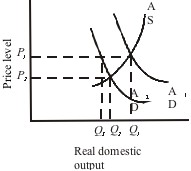 |
| 1 |  | 
Suppose the full-employment level of GDP is $250 billion. Currently, aggregate expenditures total $220 billion. Which of the following would be most in accord with appropriate fiscal policy? |
|  | A) | Reduce tax rates on personal income |
|  | B) | Reduce government expenditures |
|  | C) | Raise the tax on corporate income to discourage investment |
|  | D) | Raise the interest rate on government bonds to encourage saving |
|
|
 |
| 2 |  | 
Which of the following discretionary policies both restrains the growth of government and stabilizes the economy at full-employment? |
|  | A) | A tax cut in a recession |
|  | B) | A tax increase during inflation |
|  | C) | An increase in government spending during a recession |
|  | D) | A decrease in government spending in a recession |
|
|
 |
| 3 |  | 
An increase in the tax rate, all else equal, will: |
|  | A) | reduce the size of cyclical deficits |
|  | B) | increase the regressivity of the tax system |
|  | C) | increase the built-in stability of the economy |
|  | D) | reduce the built-in stability of the economy |
|
|
 |
| 4 |  | 
Suppose the government's actual budget is in balance but its standardized budget shows a surplus. It can be concluded that: |
|  | A) | the government's fiscal policy is expansionary |
|  | B) | the economy is actually operating at full employment |
|  | C) | the economy is experiencing demand-pull inflation |
|  | D) | The economy is currently operating below its potential |
|
|
 |
| 5 |  | 
In 2002, the Federal government spent $2472 billion while its revenues were $2154 billion. The $318 billion difference is the: |
|  | A) | full-employment budget |
|  | B) | deficit |
|  | C) | surplus |
|  | D) | public debt |
|
|
 |
| 6 |  | 
Answer the next question using the following graph:
 <a onClick="window.open('/olcweb/cgi/pluginpop.cgi?it=jpg::::/sites/dl/free/0073273082/384258/quiz11b_6.jpg','popWin', 'width=NaN,height=NaN,resizable,scrollbars');" href="#"><img valign="absmiddle" height="16" width="16" border="0" src="/olcweb/styles/shared/linkicons/image.gif"> (7.0K)</a> <a onClick="window.open('/olcweb/cgi/pluginpop.cgi?it=jpg::::/sites/dl/free/0073273082/384258/quiz11b_6.jpg','popWin', 'width=NaN,height=NaN,resizable,scrollbars');" href="#"><img valign="absmiddle" height="16" width="16" border="0" src="/olcweb/styles/shared/linkicons/image.gif"> (7.0K)</a>
Refer to the graph. If AD1 represents the current level of expenditures and Q2 is the full-employment level of GDP the economy is: |
|  | A) | in a recession and expansionary fiscal policy is in order |
|  | B) | in a recession and contractionary fiscal policy is in order |
|  | C) | experiencing demand-pull inflation and expansionary fiscal policy is in order |
|  | D) | experiencing demand-pull inflation and contractionary fiscal policy is in order |
|
|
 |
| 7 |  | 
Approximately what proportion of the U.S. public debt is "owed to ourselves," either as securities held by the U.S. public or by U.S. governments? |
|  | A) | less than 25% |
|  | B) | 25% to 50% |
|  | C) | 50% to 70% |
|  | D) | more than 70% |
|
|
 |
| 8 |  | 
Built-in stabilizers: |
|  | A) | automatically increase the size of deficits when the economy experiences demand-pull inflation |
|  | B) | avoid the problems associated with the administrative lag of discretionary fiscal policy |
|  | C) | automatically produce a cyclically balanced budget |
|  | D) | tend to offset the impact of discretionary fiscal policy |
|
|
 |
| 9 |  | 
If the MPC is .6, a $100 billion lump-sum tax cut would shift the aggregate demand curve to the right by: |
|  | A) | $25 billion |
|  | B) | $60 billion |
|  | C) | $150 billion |
|  | D) | $250 billion |
|
|
 |
| 10 |  | 
Congressional changes in taxes and spending intended to stabilize the economy: |
|  | A) | are mandated by the Federal Reserve Act of 1913 |
|  | B) | is referred to as discretionary fiscal policy |
|  | C) | offsets the economy's built-in stabilizers |
|  | D) | are designed to expand GDP in times of demand-pull inflation |
|
|

